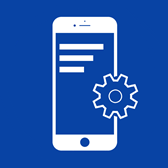
In today’s technology laden world, mobile apps have become a significant part of our daily lives. There are 3.8 billion cell phone users worldwide, which makes it easy to understand how they have become so relevant. Regardless of whether you are looking for a recipe or checking emails, the reliance on mobile apps continues to grow.
Have you ever thought about how mobile apps are created? Development no longer requires knowledge of complicated programming languages. Apps are now created using mobile app development frameworks. One can create a quality mobile application with basic knowledge of web development like CSS, HTML and JavaScript.
In this blog we will examine the top 10 frameworks for mobile app development which we expect to dominate the market next year and beyond.
PhoneGap
PhoneGap is a cross-platform mobile app development structure. It utilizes HTML5 and CSS3 as its core dialects, which makes it versatile because you can incorporate mobile tech such as the camera, accelerometer, and GPS into the app. PhoneGap is relatively simple to learn and allows engineers to compose a single app that can be used across different mobile devices without the need for different versions for each OS.
Xamarin
Xamarin is an open-source, cross-platform mobile app structure created by Microsoft. This structure permits the formation of top tier mobile apps utilizing a product system including .Net and the C# programming language. The mobile apps created with Xamarin contain an adaptable local performance that offers end users an exceptional experience. Utilizing Xamarin, engineers can make a system with backend, API, parts, and so on. Additionally, it is very easy to coordinate a few devices, libraries, and programming dialects to simplify the app development.
Appcelerator Titanium
Appcelerator is an open-source, cross-platform app development structure that allows engineers to construct local apps for different platforms like Android, iOS, and Windows, utilizing a solitary codebase. It utilizes implicit UI parts that simplify app development and prompt quicker development of easy-to-understand mobile apps. Appcelerator joins its own APIs and UP parts to create an app with exceptional performance. This structure is cloud-synchronized, which allows designers use it whenever and where ever they need it.
Respond Native
Respond Native is a JavaScript-based app development structure released by Facebook in 2018. This structure is highly sought after among app engineers worldwide, and on average 42% of mobile app developers use it for development. The reason it is so popular is that the platform permits designers to make a mobile app with a local look and feel for both Android and iOS devices.
Cross-platform app development utilizing a solitary code is the vital feature of this system, which makes it widely used by anyone from app engineers to entrepreneurs.
Vacillate
Vacillate is Google’s UI tool stash that guarantees the development of outwardly appealing, local-like applications for different working frameworks and devices utilizing a solitary codebase. This open-source mobile app SDK utilizes tools for making responsive mobile applications. This component allows engineers to modify existing applications and make new ones quickly. Likewise, a 2D designs motor named Skia allows engineers to make a genuinely local feel.
Crown SDK
Crown SDK is a widely known open-source app development system tailored to the creation of game apps for mobile devices. This structure depends on the Lua prearranging language that is lightweight, simple to use, and adaptable to strengthen game apps. Crown SDK is exceptionally well known for creating cross-platform mobile game apps available on different platforms like iOS, Android, and Nook.
Ionic
Ionic is an open-source mobile application system dependent on Angular and Apache Cordova. This system allows designers to assemble cross-platform mobile apps for the three most prominent platforms, Android, iOS, and Windows. The mobile applications assembled utilizing Ionic are strong and highlight rich local applications with consistent app performance.
The Ionic structure works with app developers to join UI components like rundown sees, channels, forms, activity sheets, route menus, and so forth to fortify the app plan. The ionic structure works best when designers incorporate coding dialects like HTML, JavaScript, or CSS.
Swiftic
Swiftic is an app development structure for iOS and Android devices. It is simple to use because of its user friendly interface. You can create, manage, publish, and edit your app all from the control panel. Swiftic comes with a 30-day guarantee for every one of its plans. Likewise,
Mobile Angular UI
The Mobile Angular UI is a mix of HTML5, Bootstrap, and AngularJs. People who are comfortable working with Twitter Bootstrap and AngularJS can undoubtedly utilize Mobile Angular UI for app development. On a very basic level, the mobile UI structure gives a scope of app development parts that were missing in Bootstrap 3 such as, overlays, switches, sidebars, and scrollable regions. Mobile Angular UI uses fastclick.js and overthrow.js as its libraries for the development of current web and mobile applications.
Local Script
Local Script is a mobile app development structure that lets the development of local applications for both Android and iOS utilize a solitary codebase. Local Script utilizes Angular, JS, Vue.js, SML, CSS, and others to join local APIs as opposed to utilizing web perspectives to deliver the UI. It gives apps local-like performance using all iOS and Android APIs.
Wrapping up
The framework you decide to go with is totally up to you. These incredible frameworks are an ideal mix of different programming languages, making mobile app development very straightforward. You can click here to learn more about a phonegap development company. This resource can help you decide on an OS, understand development time, and different parts of making an ideal mobile app for your business.
